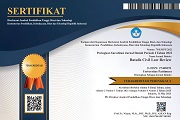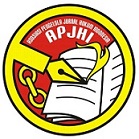Pemanfaatan Lahan Kawasan Hutan Lindung Oleh Masyarakat Hukum Adat, Masyarakat Lokal, dan Masyarakat Dari Luar Kawasan
 ), Abrar Saleng(2), Kahar Lahae(3)
), Abrar Saleng(2), Kahar Lahae(3)
(1) Fakultas Hukum Universitas Hasanuddin, Makassar, Indonesia
(2) Fakultas Hukum Universitas Hasanuddin, Makassar, Indonesia
(3) Fakultas Hukum Universitas Hasanuddin, Makassar
 Corresponding Author
Corresponding Author
Abstract
Keywords
DOI
10.47268/ballrev.v3i2.832
Published
2022-08-26
How To Cite
@article{BALLREV832,
author = {Sri Muh.Saleh and Abrar Saleng and Kahar Lahae},
title = {Pemanfaatan Lahan Kawasan Hutan Lindung Oleh Masyarakat Hukum Adat, Masyarakat Lokal, dan Masyarakat Dari Luar Kawasan},
journal = {Batulis Civil Law Review},
volume = {3},
number = {2},
year = {2022},
keywords = {Protected Forest; Indigenous Peoples; Forest Encroachment; Corporation},
abstract = {This study aims to find out and examine how the land use of protected forest areas by the community in East Luwu Regency is used. This study uses an empirical juridical method, using a qualitative approach, on all legal principles/rules of law, both material law and how these provisions are confronted in a fact/reality that occurs in the field. The results of this study indicate that the use of protected forest areas by the community in East Luwu Regency is divided between customary law communities, local communities, and people from outside the area. There is injustice for indigenous peoples in fulfilling the quality of their economy, because they do not yet have a designated area, the existence of their customary forest is disturbed by looting and illegal logging carried out by people outside the area. Meanwhile, local communities often receive warnings when using forests because the boundaries of the areas they can use are not clear. Communities outside the area who encroach on protected forests which are unlawful acts. Community conflicts outside the area, in this case corporations, also conflict with the interests of indigenous peoples and local communities because their interests or rights are disturbed between one another.},
issn = {2746-8151}, pages = {126--136} doi = {10.47268/ballrev.v3i2.832},
url = {https://fhukum.unpatti.ac.id/jurnal/ballrev/article/view/832}
}
| Dublin Core | PKP Metadata Items | Metadata for this Document | |
| 1. | Title | Title of document | Pemanfaatan Lahan Kawasan Hutan Lindung Oleh Masyarakat Hukum Adat, Masyarakat Lokal, dan Masyarakat Dari Luar Kawasan |
| 2. | Creator | Author's name, affiliation, country | Sri Rahayu Muh.Saleh; Fakultas Hukum Universitas Hasanuddin, Makassar; Indonesia |
| 2. | Creator | Author's name, affiliation, country | Abrar Saleng; Fakultas Hukum Universitas Hasanuddin, Makassar; Indonesia |
| 2. | Creator | Author's name, affiliation, country | Kahar Lahae; Fakultas Hukum Universitas Hasanuddin, Makassar |
| 3. | Subject | Discipline(s) | |
| 3. | Subject | Keyword(s) | Protected Forest; Indigenous Peoples; Forest Encroachment; Corporation |
| 4. | Description | Abstract | This study aims to find out and examine how the land use of protected forest areas by the community in East Luwu Regency is used. This study uses an empirical juridical method, using a qualitative approach, on all legal principles/rules of law, both material law and how these provisions are confronted in a fact/reality that occurs in the field. The results of this study indicate that the use of protected forest areas by the community in East Luwu Regency is divided between customary law communities, local communities, and people from outside the area. There is injustice for indigenous peoples in fulfilling the quality of their economy, because they do not yet have a designated area, the existence of their customary forest is disturbed by looting and illegal logging carried out by people outside the area. Meanwhile, local communities often receive warnings when using forests because the boundaries of the areas they can use are not clear. Communities outside the area who encroach on protected forests which are unlawful acts. Community conflicts outside the area, in this case corporations, also conflict with the interests of indigenous peoples and local communities because their interests or rights are disturbed between one another. |
| 5. | Publisher | Organizing agency, location | Faculty of Law, Universitas Pattimura |
| 6. | Contributor | Sponsor(s) | |
| 7. | Date | (YYYY-MM-DD) | 2022-08-26 |
| 8. | Type | Status & genre | Peer-reviewed Article |
| 8. | Type | Type | |
| 9. | Format | File format | |
| 10. | Identifier | Uniform Resource Identifier | https://fhukum.unpatti.ac.id/jurnal/ballrev/article/view/832 |
| 10. | Identifier | Digital Object Identifier | 10.47268/ballrev.v3i2.832 |
| 11. | Source | Title; vol., no. (year) | Batulis Civil Law Review; Vol 3, No 2 (2022): VOLUME 3 NOMOR 2, NOVEMBER 2022 |
| 12. | Language | English=en | en |
| 13. | Relation | Supp. Files | |
| 14. | Coverage | Geo-spatial location, chronological period, research sample (gender, age, etc.) | |
| 15. | Rights | Copyright and permissions | Copyright: Authors who publish their manuscripts in this Journal agree to the following conditions: 1. The copyright in each article belongs to the author, as well as the right to patent. 2. Authors are able to enter into separate, additional contractual arrangements for the non-exclusive distribution of the journal's published version of the work (e.g., post it to an institutional repository or publish it in a book), with an acknowledgment of its initial publication in this journal. 3. Authors are permitted and encouraged to post their work online (e.g., in institutional repositories or on their website) prior to and during the submission process, as it can lead to productive exchanges, as well as earlier and greater citation of published work. 4. Authors have the right to self-archiving of the article (Author Self-Archiving Policy)
Licence : Batulis Civil Law Review Journal is disseminated based on the Creative Commons Attribution-NonCommercial 4.0 International license terms. This license allows anyone to copy and redistribute this material in any form or format, compose, modify, and make derivatives of this material for any purpose. You cannot use this material for commercial purposes. You must specify an appropriate name, include a link to the license, and certify that any changes have been made. You can do this in a way that is appropriate, but does not imply that the licensor supports you or your use.
|
Copyright (c) 2022 Sri Rahayu Muh. Saleh, Abrar Saleng, Kahar Lahae

This work is licensed under a Creative Commons Attribution-NonCommercial 4.0 International License.

 : 2209 times
: 2209 times Download : 1961 times
Download : 1961 times














